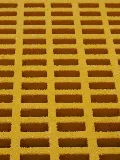loading...
- No. 9, Xingyuan South Street, Dongwaihuan Road, Zaoqiang County, Hengshui, Hebei, China
- admin@zjcomposites.com
- +86 15097380338
- Welcome to visit our website!
Innovative Solutions for Durable Walkway FRP Grating Applications in Various Industries
The Benefits of Walkway FRP Grating A Comprehensive Overview
In the realm of industrial and commercial construction, the choice of materials plays a crucial role in the safety, efficiency, and longevity of structures. One material that is gaining significant attention is Fiber Reinforced Polymer (FRP) grating. Particularly, walkway FRP grating is increasingly being utilized in various applications due to its unique characteristics and advantages.
FRP grating is composed of a polymer matrix reinforced with fibers, typically fiberglass. This composite material offers a high strength-to-weight ratio, making it an optimal choice for walkways in many environments. The lightweight nature of FRP grating allows for ease of installation and reduced transportation costs, which can be a significant factor for large projects. Moreover, its corrosion-resistant properties make it particularly suited for harsh environments such as chemical plants, water treatment facilities, and coastal applications where traditional materials like steel and wood may deteriorate rapidly.
The Benefits of Walkway FRP Grating A Comprehensive Overview
In addition to safety, durability is another hallmark of FRP grating. Unlike traditional materials, FRP does not rust, rot, or corrode, substantially increasing its lifespan and reducing maintenance costs over time. This durability means that facilities can save money on repairs and replacements, allowing for more efficient budgeting and resource allocation. Furthermore, the intrinsic properties of FRP grating contribute to fewer environmental impacts, as its longevity means less frequent replacements and reduced waste generation.
walkway frp grating

Another advantage of walkway FRP grating is its versatility. It is available in various configurations, including different panel sizes and load-bearing capacities, making it suitable for a diverse range of applications. From pedestrian walkways in parks to heavy-duty industrial platforms, FRP grating can be customized to meet specific project requirements. Its design flexibility extends to a variety of finishes and colors, allowing organizations to integrate aesthetic considerations alongside functionality.
Environmental considerations further bolster the case for walkway FRP grating. Many manufacturers utilize sustainable practices in their production processes, making FRP a more environmentally friendly option than traditional materials. Additionally, its lightweight nature contributes to lower carbon emissions during transportation and installation.
Moreover, the ease of installation associated with FRP grating cannot be overstated. Unlike metal grating, which may require heavy machinery and extensive labor, FRP can often be installed quicker and with fewer resources. This efficiency translates to reduced labor costs and shorter project timelines, providing a substantial benefit for contractors and clients alike.
In conclusion, walkway FRP grating presents a unique combination of safety, durability, versatility, and environmental sustainability, making it an ideal choice for modern construction projects. As industries increasingly prioritize efficiency and worker safety, the adoption of innovative materials like FRP grating is sure to grow. This composite material not only meets but often exceeds the demands of contemporary infrastructure, paving the way for safer and more sustainable working environments. Whether in industrial facilities, commercial buildings, or public spaces, walkway FRP grating stands out as a material of the future.
-
GRP Structures: The Future of Lightweight, High-Performance EngineeringNewsJun.20,2025
-
FRP Water Tank: High-Performance Storage for Corrosive and Clean Water SystemsNewsJun.20,2025
-
FRP Square Tube: The New Industry Standard for Chemical and Structural ApplicationsNewsJun.20,2025
-
FRP Pultruded Profiles: The Ultimate Choice for Lightweight Structural StrengthNewsJun.20,2025
-
FRP Handrails: The Safer, Smarter, and Stronger Choice for Modern InfrastructureNewsJun.20,2025
-
FRP Grating: The Smart Solution for Durable, Lightweight Industrial FlooringNewsJun.20,2025
-
Why Choose a Galvanized Water Tank for Your Storage NeedsNewsMay.21,2025
